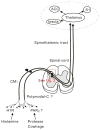Anatomy and neurophysiology of pruritus
- PMID: 21767766
- PMCID: PMC3694590
- DOI: 10.1016/j.sder.2011.04.001
Anatomy and neurophysiology of pruritus
Abstract
Itch has been described for many years as an unpleasant sensation that evokes the urgent desire to scratch. Studies of the neurobiology, neurophysiology, and cellular biology of itch have gradually been clarifying the mechanism of itch both peripherally and centrally. The discussion has been focused on which nerves and neuroreceptors play major roles in itch induction. The "intensity theory" hypothesizes that signal transduction on the same nerves leads to either pain (high intensity) or itch (low intensity), depending on the signal intensity. The "labeled-line coding theory" hypothesizes the complete separation of pain and itch pathways. Itch sensitization must also be considered in discussions of itch. This review highlights anatomical and functional properties of itch pathways and their relation to understanding itch perception and pruritic diseases.
Copyright © 2011 Elsevier Inc. All rights reserved.
Figures


Similar articles
-
Peripheral and Central Mechanisms of Itch.Neuron. 2018 May 2;98(3):482-494. doi: 10.1016/j.neuron.2018.03.023. Neuron. 2018. PMID: 29723501 Free PMC article. Review.
-
Molecular mechanisms of pruritus.Curr Res Transl Med. 2016 Oct-Dec;64(4):203-206. doi: 10.1016/j.retram.2016.08.006. Epub 2016 Nov 4. Curr Res Transl Med. 2016. PMID: 27939459 Review.
-
Sensory neurons and circuits mediating itch.Nat Rev Neurosci. 2014 Jan;15(1):19-31. doi: 10.1038/nrn3641. Nat Rev Neurosci. 2014. PMID: 24356071 Free PMC article. Review.
-
Peripheral Mechanisms of Itch.Curr Probl Dermatol. 2016;50:18-23. doi: 10.1159/000446012. Epub 2016 Aug 23. Curr Probl Dermatol. 2016. PMID: 27578066 Free PMC article. Review.
-
Central Mechanisms of Itch.Curr Probl Dermatol. 2016;50:11-7. doi: 10.1159/000446011. Epub 2016 Aug 23. Curr Probl Dermatol. 2016. PMID: 27578065 Free PMC article. Review.
Cited by
-
Peripheral and Central Mechanisms of Itch.Neuron. 2018 May 2;98(3):482-494. doi: 10.1016/j.neuron.2018.03.023. Neuron. 2018. PMID: 29723501 Free PMC article. Review.
-
New insights into the mechanisms of itch: are pain and itch controlled by distinct mechanisms?Pflugers Arch. 2013 Dec;465(12):1671-85. doi: 10.1007/s00424-013-1284-2. Epub 2013 May 1. Pflugers Arch. 2013. PMID: 23636773 Free PMC article. Review.
-
N-palmitoylethanolamine and N-acetylethanolamine are effective in asteatotic eczema: results of a randomized, double-blind, controlled study in 60 patients.Clin Interv Aging. 2014 Jul 17;9:1163-9. doi: 10.2147/CIA.S65448. eCollection 2014. Clin Interv Aging. 2014. PMID: 25071367 Free PMC article. Clinical Trial.
-
The Role and Treatment Implications of Peripheral and Central Processing of Pain, Pruritus, and Nausea in Heightened Somatic Awareness: A Review.Innov Clin Neurosci. 2017 Jun 1;14(5-6):11-20. eCollection 2017 May-Jun. Innov Clin Neurosci. 2017. PMID: 28979822 Free PMC article. Review.
-
Relations between a standardized experimental stressor and cutaneous sensory function in patients with chronic pruritus and healthy controls: an experimental case-control study.J Eur Acad Dermatol Venereol. 2018 Dec;32(12):2230-2236. doi: 10.1111/jdv.15030. Epub 2018 Aug 5. J Eur Acad Dermatol Venereol. 2018. PMID: 29706009 Free PMC article.
References
-
- Ikoma A, Steinhoff M, Ständer S, et al. The neurobiology of itch. Nat Rev Neurosci. 2006;7:535–547. - PubMed
-
- Jutel M, Akdis M, Akdis CA. Histamine, histamine receptors and their role in immune pathology. Clin Exp Allergy. 2009;39:1786–1800. - PubMed
-
- Greaves MW, Davies MG. Histamine receptors in human skin: Indirect evidence. Br J Dermatol. 1982;107 (suppl 23):101–105. - PubMed
-
- Rosenthal SR. Histamine as the chemical mediator for cutaneous pain. J Invest Dermatol. 1977;69:98–105. - PubMed
Publication types
MeSH terms
Grants and funding
LinkOut - more resources
Full Text Sources
Other Literature Sources
Medical
Research Materials
